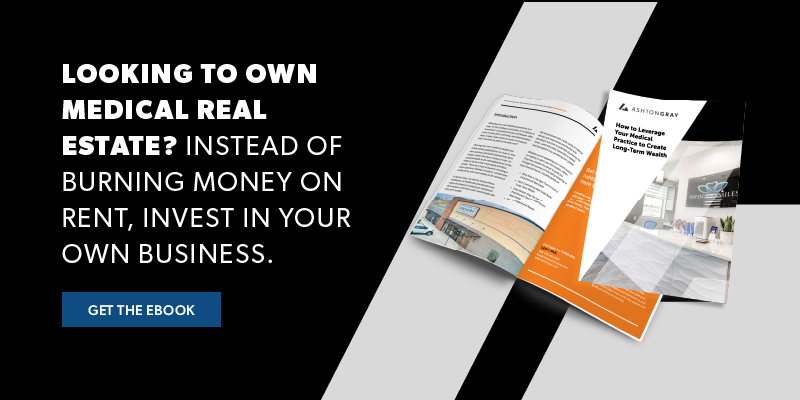
3 Big Questions to Ask Before Investing in Medical Real Estate
The list of benefits of owning your own healthcare real estate is long. As opposed to renting, owning real estate can provide medical practitioners with an additional income stream, increase overall net worth, tax breaks, a retirement strategy, and much more control over the vision of their business in the long term.
With so much upside to owning your own medical office and the associated real estate, it’s not surprising that many medical doctors and practitioners are wondering where to start.
Below are three big questions to ask before investing in medical real estate, so you can begin forming a plan and take your practice and investments to new heights.
Who Are Your Patients?
 “Once you understand your ideal patients, you’ll know where you need to be located,” says Cole Smith, Developer at Ashton Gray.
“Once you understand your ideal patients, you’ll know where you need to be located,” says Cole Smith, Developer at Ashton Gray.
Who are the people that need your services? Where do they live and work?
One of the best ways to get a handle on your ideal patients is by researching demographics. Things like age, income, employment, and marital status are crucial to understanding your potential patient base and whether your business will be a good fit for the area.
For example, areas with a high density of young married couples and quality school systems might be good indications that an area is ripe for pediatricians.
“If you are a pediatrician you want to be within neighborhood communities close to schools and grocery stores.”
A time-tested tool for finding and speaking to your patient base is marketing personas. Marketing personas are an internal representation of your patients based on demographics, psychographics, and your own data from your practice. It’s an avatar of your patient base, which can be referred to when making business decisions.
What is your Target Area’s Economic Outlook?
Directly tied in with an area’s demographics is the economic outlook. There are a ton of data resources that provide clues as to whether a particular area is growing, shrinking, or maintaining, such as the Bureau of Labor Statistics.
A common mistake we see at Ashton Gray is doctors trying to establish their new practice in an already saturated area. In theory, it sounds great to move into an area with a bustling downtown and other thriving practices, but often times you can find more success elsewhere.
One of the strategies we deploy is following new housing development. Housing is often the first type of construction in a new area, which presents an opportunity for other businesses, like your medical practice, to move in and grow with the community. This means a higher likelihood of establishing patient loyalty and creating a recognizable brand.
But to identify the best sites in expanding areas requires coordination of development expertise, surveyors, and even sometimes an archaeologist. This was the case during a recent project in Tulsa, Oklahoma, where we had to enlist the help of a local archaeologist to ensure there were no historic artifacts that would be disturbed on-site.
But moving into a less saturated, expanding area might not always make sense for your practice. If you rely on referrals, then you may want to establish yourself in a more saturated, developed area, where you can build relationships with other doctors.
What are the Size, Layout, and Infrastructure/Equipment Requirements for your Facility?
At Ashton Gray, we’ve helped guide dentists, veterinarians, medical doctors, and more through the full development of new facilities, as well as move practices into pre-existing buildings. Not only are buildings different from practice to practice, but the same business can be vastly different from location to location.
“It is important to ask the question,” Cole says, “What is needed in a space and location for my team and patients to have the best possible experience?”
Start with fulfilling your practice’s core functionality, then find ways it can be improved upon. Also, keep in mind how the trajectory of your practice – are you still growing? How long do you plan on keeping this practice location open?
“Take into consideration timeframe and growth rate for the practice when thinking about new space or 2nd generation,” Cole says. “If a practice has 20 more years to be in operation, then occupying new space now will get you much further than space that may already be on the decline.”
Are you hoping to create a high-end experience for your patients? Or just focused on getting your practice off the ground?
“How do you want to be perceived by your patients,” asks Cole. “Consider the effect that new, modern, clean, highly efficient space will impact your patient base.”
Also, as medical retail becomes increasingly popular, and patients demand more convenient medical care, you’ll want to consider your practice’s accessibility and visibility.
“Convenient location and ease of access are important to create a loyal patient,” advises Cole.
In addition, medical retail locations are more easily navigatable than a large hospital campus, can be incorporated into a busy patient’s errands, and provide practitioners with more opportunities for a flexible and customized business model.
Got More Medical Real Estate Questions? Ashton Gray Can Help
Those are the three big questions you should ask yourself before investing in medical real estate. But as you dive deeper into each, you’ll likely find yourself asking quite a few more questions about the best way to create your ideal practice.
It’s understandable, starting a medical practice from the ground up is no small feat, but the team at Ashton Gray is here to help you with any questions you may have along your journey.
